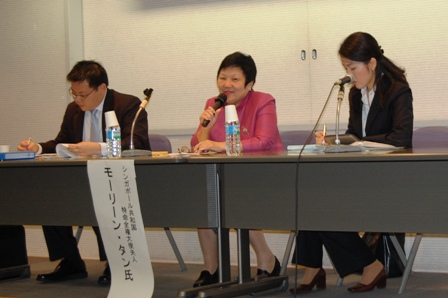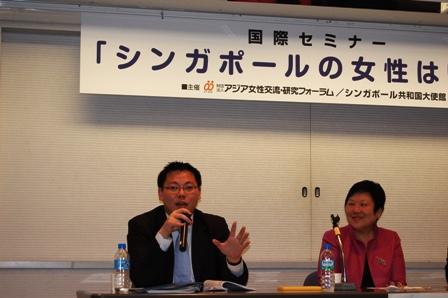On October 26, KFAW co-hosted an international seminar with the Embassy of the Republic of Singapore. This event was organized with the support of Ms. Hatsuko OSHIMA, Board Member of the Asia-Pacific Ladies Friendship Society, comprised mainly of the wives of ambassadors of 24 Asia-Pacific countries to Japan.
| 1.Date | October 26, 2009 (Monday) 15:00~16:45 |
| 2.Venue | Kitakyushu Municipal Gender Equality Center “MOVE” |
| 3.Number of attendees | 80 |
| 4.Organizer | KFAW The Embassy of the Republic of Singapore |
| 5.Lecturer | Ms. Maureen Tan (spouse of Ambassador of the Republic of Singapore) |
 |
| Staff members of the Singapore Embassy |
Ms. Maureen TAN, spouse of the Ambassador of the Republic of Singapore, spoke before an audience of some 80 persons regarding the current status of Singaporean women, and responded to questions from the participants. Before the speech, Ms. Keiko TAMURA, Board Member of KFAW and professor at the University of Kitakyushu, who was serving as moderator, introduced Singapore, a multi-ethnic country about the same size as Awaji Island, with a population of close to 5 million (4.99 million in 2009). While the statistics on the wage gap between men and women, and the proportion of women at management levels in government and business, showed the active participation of women in society, Singapore’s birth-rate was declining and the percentage of unmarried people was increasing.
At the beginning of her speech, Ms. Tan elaborated on the situation in Singapore, where women’s participation in society was encouraged. However, notwithstanding these efforts, the traditional view, that men should work to support the family while the role of women is to raise and educate children as a good assistant for the husband, was still present in society to some degree.
Ms. Tan’s view was that women wanted to work. However, many women faced the challenge of working and raising children at the same time. While the government offered incentives to help, there were still many women who quit their jobs when they had a baby. After her pregancey, a woman often found it difficult to return to the same position that she had left. As such, many women were actually giving up their careers when they became mothers.
Ms. Tan shared that she had worked for 35 years as a teacher while raising two sons, and she too had faced a similar problem when she was a young working mother. Today, however, the government encourages young women to work. According to her experience, mothers in the first ten-year period of child-raising often feel torn between their work and the fear that they are not taking good care of their children. If they can get through this first ten-year period, they can continue their careers because children at the age of eight to ten can be taken care of by someone after school.
 |
| Right:Ms. TAN, Left:Mr. KHOO Seow Fong |
Ms. Tan recalled that she would have found it very challenging to work and bring up two sons without the assistance of a domestic helper. She explained that in Singapore, one could engage domestic helpers, many of whom are foreigners. It used to be difficult to employ foreigners for household work but that has changed.
Whether a woman returns to work after having a baby is a choice left up to the woman herself. However, various incentives are also offered, creating a system in Singapore that enables women to continue their careers until retirement. Ms. Tan herself worked as a teacher for 35 years until retirement.
In Singapore, while the average labor participation rate of women is not sufficiently high-about the same level as Japan-the social participation rates of women have been increasing. Mr. KHOO Seow Fong, First Secretary, explained the political measures the Singapore government is currently implementing to help improve the situation.
Since Singapore has few natural resources, the government considers people an important national resource. While men are required to serve in the military at the age of 18, the government is negative about women’s military participation. Thegovernment encourages women to engage in other types of social contribution. With the aim of changing the traditional roles of men and women, the government established the Women’s Charter in 1951, which ensures the political, social and economic rights of women. The Charter was amended in 1996 to enhance protective measures for women and children and to stipulate maintenance of the family unit.
As the policy to promote equal educational opportunities for men and women boosted the proportion of female university students to about 55%, the labor articipation rate of women also rose from 50% 20 years ago, to 60%, along with improvement in women’s educational levels. Many companies, including Temasek Holdings, a government-owned investment company, and SingTel, the largest telecommunications company in Singapore, have female CEOs. The success story of Olivia Lum, CEO of Hyflux, a global water treatment company, is widely known.
In the political arena, the number of female parliament members increased from four to 22 over the past 20 years.
The increased participation and empowerment of women, however, have brought about unintended social effects. Women who have gained economic independence are no longer satisfied with the traditional roles they have been expected to play, while men are not able to catch up with the changes in women’s thinking. Thus, policies to promote gender equality have contributed to the tendency to marry late, as well as to an increase in the number of married couples unwilling to have children. As a result, the birth rate is declining sharply to a level lower than that of Japan (1.28).
To address these problems, the government is now taking the following actions:
- Introducing the “baby bonus” system. The government pays SGD 4,000 each for the first and second children, and SGD 6,000 each for the third and fourth children. (SGD 1 = approx. JPY 63, as of December 2009)
- Granting 16 weeks of paid child-care leave (The employer and the government each pay for eight weeks.)
- Providing monthly subsidies for childcare services to reduce the burden of child raising.
- Implementing various measures to encourage it women to return to work after childbirth, and to support their families.
・Reduction of income tax for working mothers with children.
・Reduction of taxes on hiring foreign household workers, etc. - Building new child-care facilities (There are now 750 facilities with a capacity of 50,000 children.)
In the question-and-answer session after the speech, discussions concerned the current ituation of Singaporean women from various viewpoints, including the ethnic difference in the women’s participation in society, welfare, medical care and support for child raising.
The participants were impressed by Singaporean women, who live with strong independent minds and are highly motivated. At the same time, some expressed concern that Japan may not be able to keep up with the progress of Asia, unless the Japanese people continue to be motivated. This seminar reminded us of the importance of human resources as a source of economic growth.


